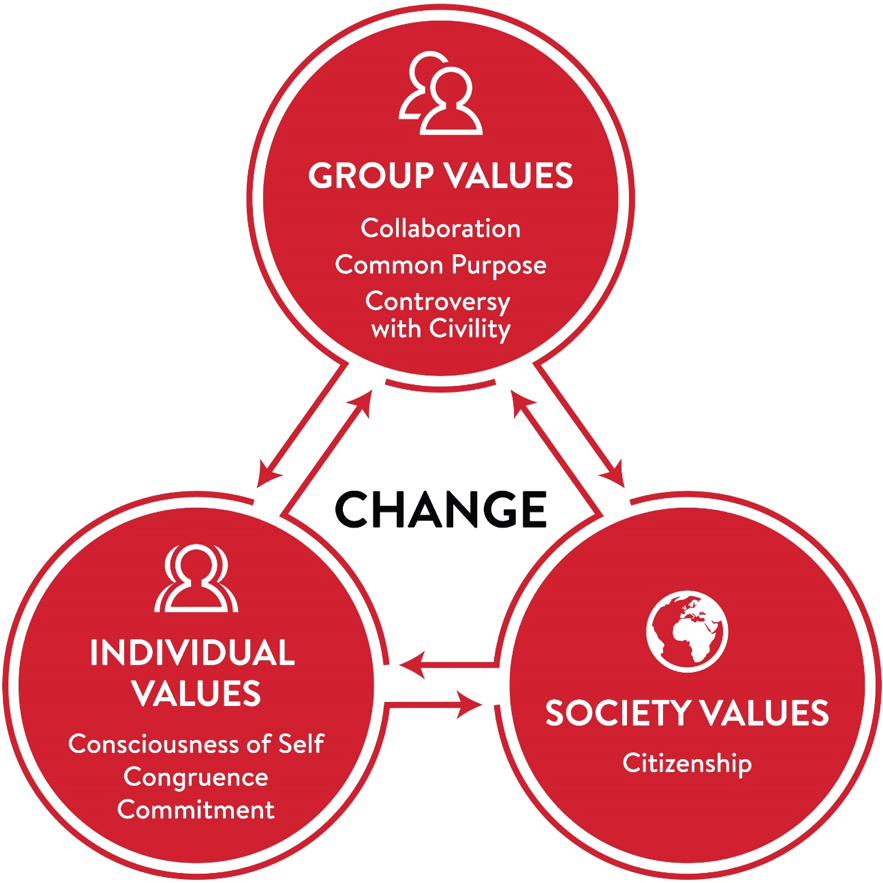Leadership at Dickinson
Campus Life ascribes to the Social Change Model (SCM) of Leadership Development created at UCLA by Helen and Alexander Astin. This model guides Campus Life in all of our work with students and grounds our work in developing Dickinson students as leaders.
Established in 1994, the Social Change Model (SCM) of Leadership Development approaches leadership as a purposeful, collaborative, values-based process that results in positive social change. The Model was built upon the following assumptions:
- Leadership is socially responsible; it impacts change on behalf of others
- Leadership is collaborative
- Leadership is a process, not a position
- Leadership is inclusive and accessible to all people
- Leadership is values-based
- Community involvement/service is a powerful vehicle for leadership.
The SCM views leadership as a purposeful, collaborative, values-driven process instead of a title or position. Leaders commit to improving the groups or communities of which they are part. In this approach to leadership, a "leader" is anyone who wants to work with others to make a difference. This collaborative process means that groups must have trust and requires that group members act in ways that are consistent with their own beliefs and values as well as the group’s goals. The team that developed the model concluded that eight values are necessary for trust, common goals, and true collaboration.
THE 7 C’S OF LEADERSHIP – SEVEN CRITICAL VALUES OF THE SOCIAL CHANGE MODEL OF LEADERSHIP DEVELOPMENT
Consciousness of Self
Awareness of the beliefs, values, attitudes, and emotions motivates one to act. This is the key to being able to develop the consciousness of others.
Congruence
Thinking, feeling, and behaving with consistency, genuineness, authenticity, and honesty towards others; actions are consistent with most deeply-held beliefs and convictions; interdependent with Consciousness of Self.
Commitment
The psychic energy that motivates the individual to serve and drives the collective effort implies passion, intensity, and duration and is directed toward both the group activity and its intended outcomes; it requires knowledge of self.
Collaboration
Working with others in a common effort constitutes the cornerstone of the group leadership effort because it empowers self and others through trust. Leadership as a group process encourages the group to transcend individual goals, interests, and behaviors; it is vital that group members explore differences in individual values, ideas, affiliations, visions, and identities.
Common purpose
To work with shared aims and values facilitates the group’s ability to engage in collective analysis of issues at hand and the task to be undertaken; best achieved when all members of the group share in the vision and participate actively in articulating the purpose and goals of the activity.
Controversy with civility
Recognizes two fundamental realities of any creative group effort: that differences in viewpoint are inevitable and that such differences must be aired openly but with civility. Civility implies respect for others, a willingness to hear each other’s views, and the exercise of restraint in criticizing the views and actions of others. Requires trust among the group members; conflicts must be resolved and integrated into the common purpose.
Citizenship
The process whereby an individual and the collaborative group become responsibly connected to the community and the society through the leadership development activity. To be a good citizen is to work for positive change for others and the community. The practice of good citizenship should and needs to happen at every level of the model.
Change (*The Eighth C)
The ability to adapt to environments and situations that are constantly evolving while maintaining the core functions of the group. Change is the value “hub” that gives meaning to the 7 Cs and is the goal of the creative process of leadership – to make a better world and a better society for self and others.
